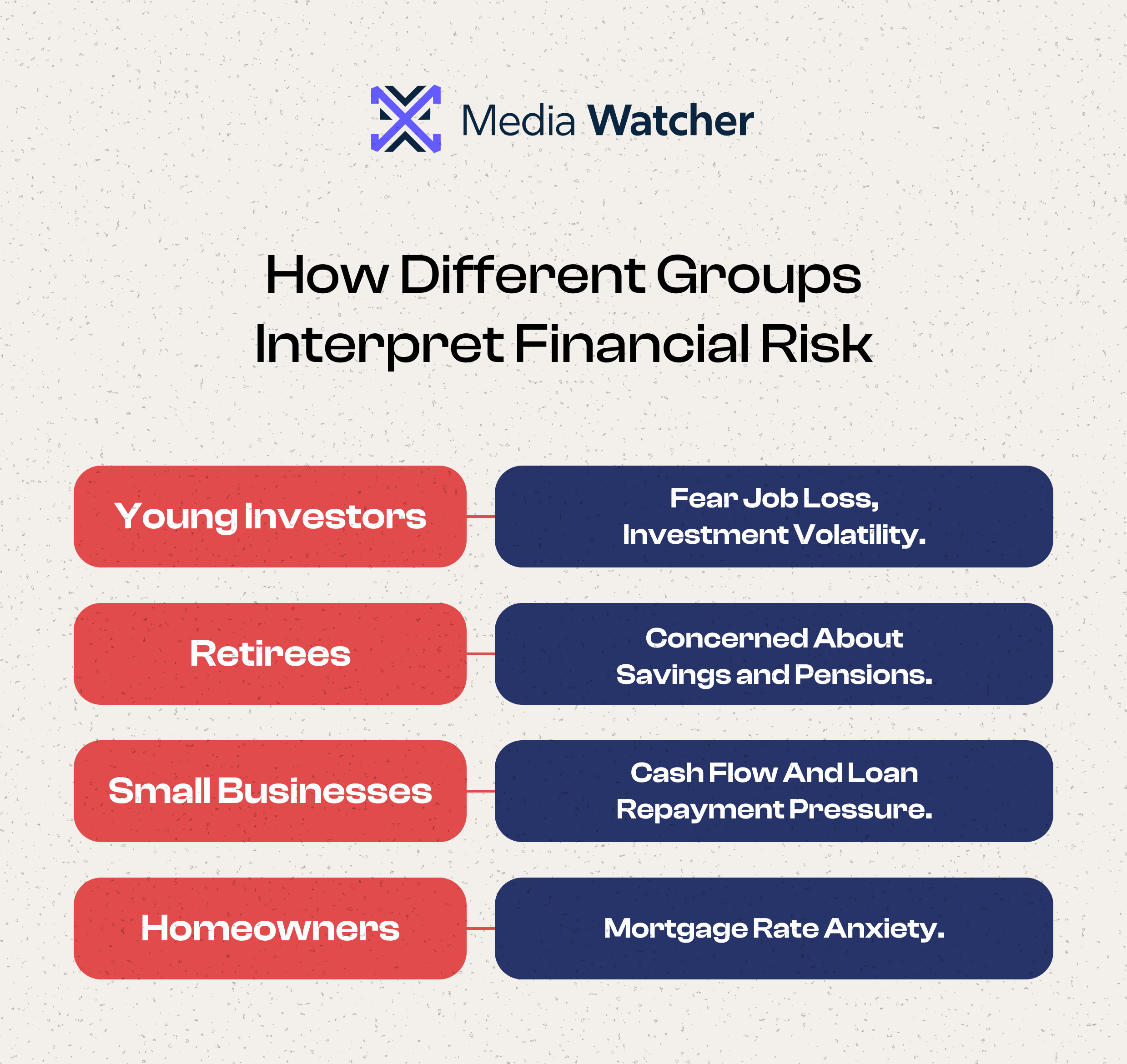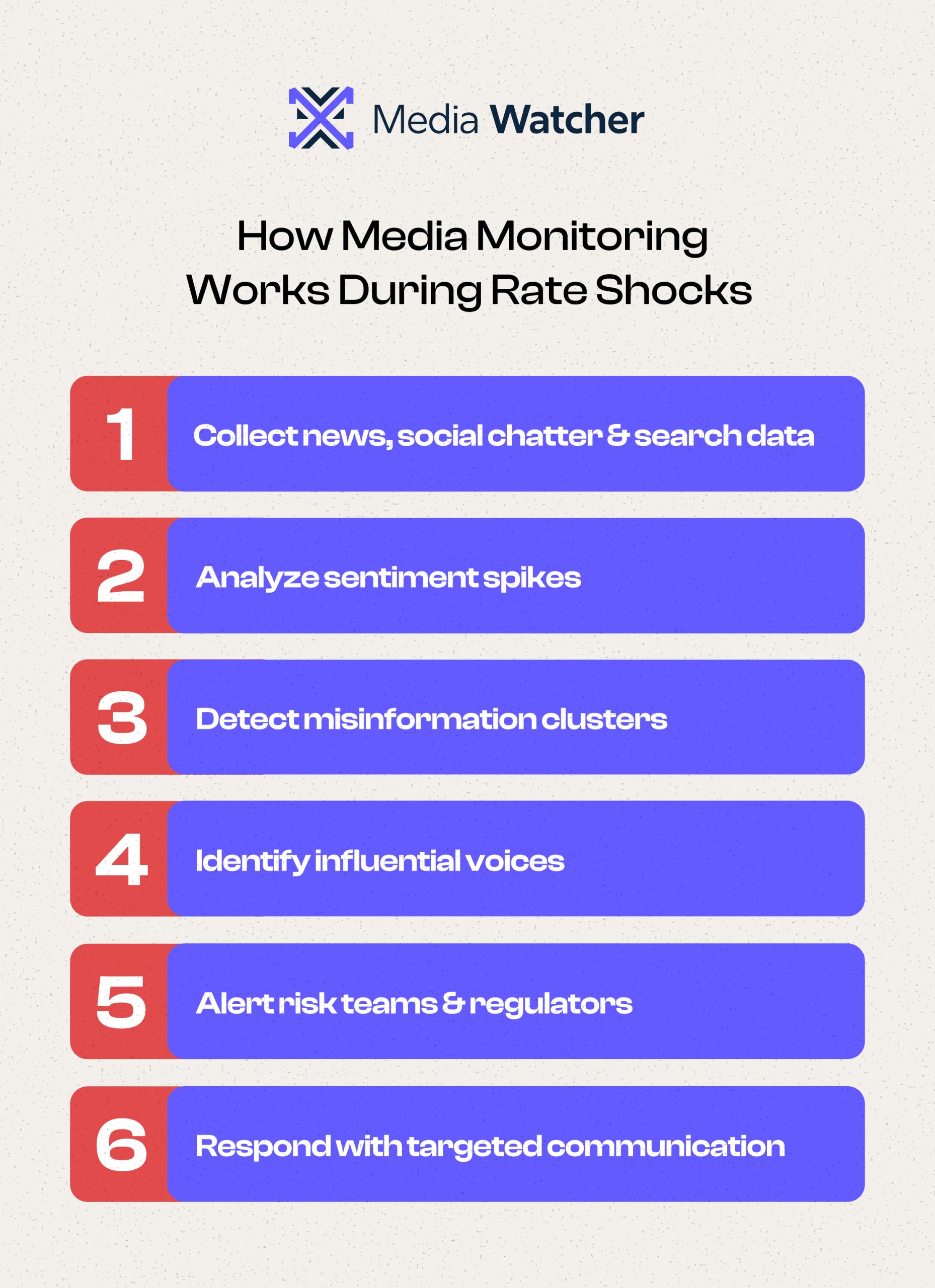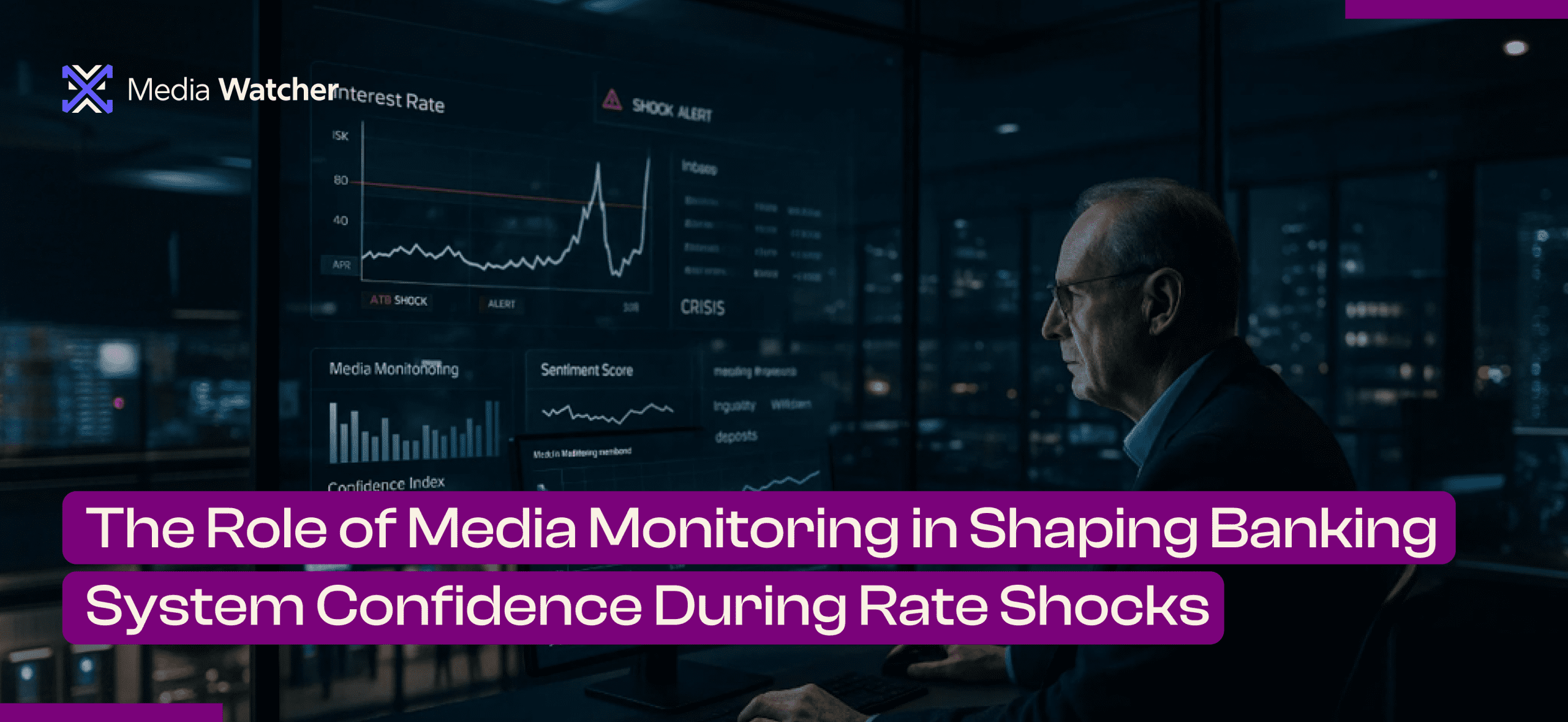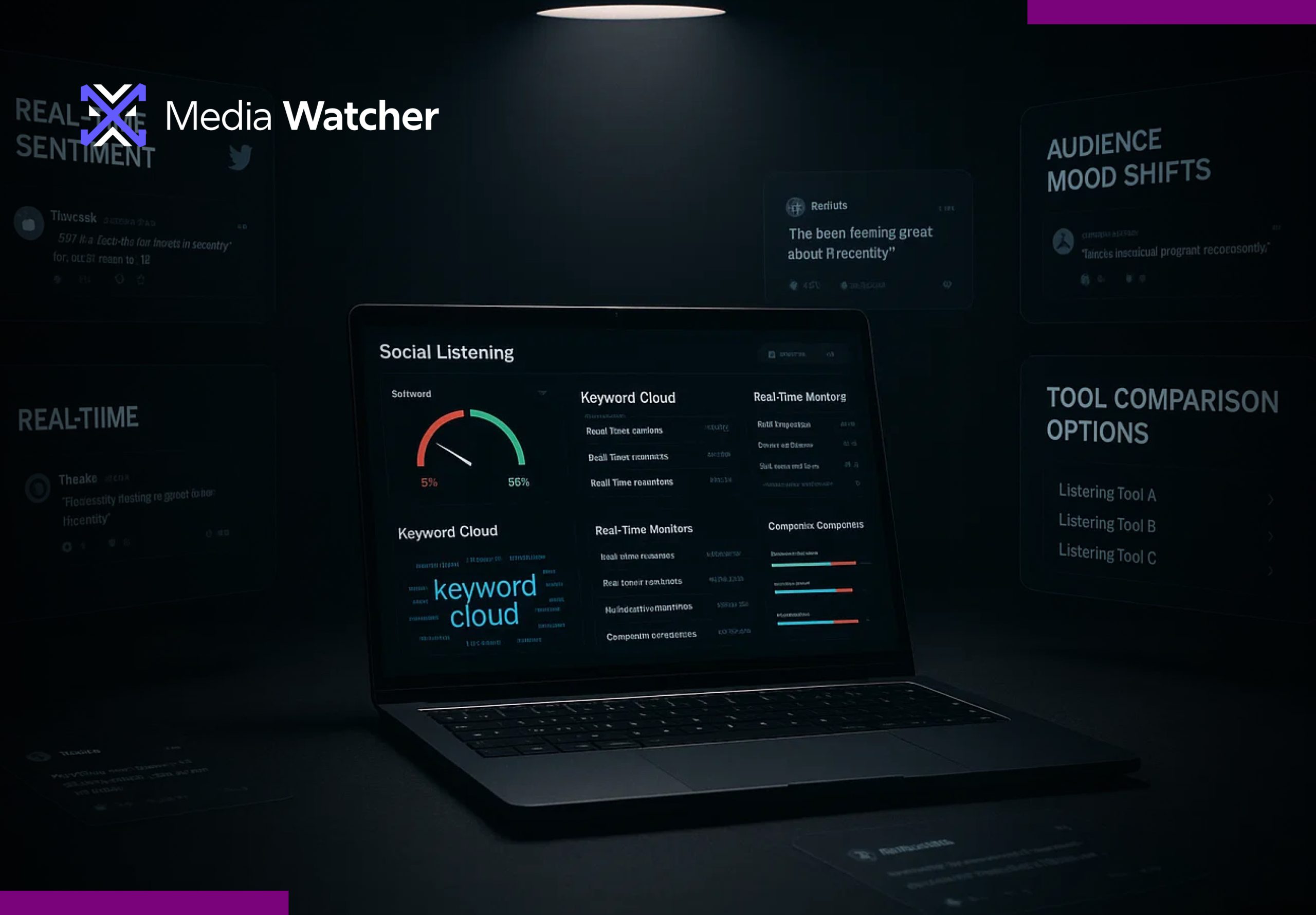Public confidence in the banking sector often shifts rapidly during volatile economic cycles. Rate shocks reshape expectations, challenge the liquidity assumptions, and induce real anxiety across retail and institutional audiences.
As the 2025 banking-sector disruption unfolds, media narratives as well as social chatter on these narratives are changing public sentiment faster than regulators can issue any formal statements.
Under these circumstances, keeping a close eye on public sentiment through media monitoring in banking crises is no longer optional but imperative for enterprises.
It enables brands to establish a relationship of trust between themselves and their consumers.
Media-monitoring technology provides regulators, risk teams, and communications leaders with the contextual insight of public reactions in crisis management, along with the emotions behind them.
By tracking search patterns, sentiment shifts, and trending narratives, they identify the point of concern and issue early warning signs that traditional indicators often miss.
This blog explores how news coverage and social chatter shape confidence during rate shocks, and why real-time sentiment intelligence matters more than ever.
Why Public Sentiments Analysis Solution Is Important for the Financial Industry
Public sentiment analysis gives banks real-time visibility into customer confidence, market reactions, and emerging concerns. Here is why it is important for the financial sector:
Media Ecosystems Accelerate Emotional Contagion During Uncertain Financial Events
When rates move sharply, people respond by seeking explanations from the sources they trust. News headlines amplify risk language, while social platforms fuel emotional contagion through speculative commentary.
These dynamics push public attention toward perceived vulnerabilities instead of confirmed data points.
Sentiment Signals Help Regulators Detect Stress Before It Manifests Materially
Regulators often see liquidity stress only after withdrawals begin. However, prompt sentiment analysis enables you to highlight early shifts in public trust before opinions and behaviors of people change.
Tracking negative spikes on the internet in real time allows authorities to formulate a proactive strategy rather than acting reactively.
Institutional Decision-Makers Need Accurate Intelligence To Guide Communication Strategy
In order to determine a clear and comprehensive strategy for the banks, decision makers need credible data on public sentiments. When decision makers have reached an understanding of how the public interprets specific narratives, they can then adjust their tone and respond timely without leaving a vacuum for doubts to surface.
Formulation of a strategy based on empirical data increases the resonance of your message and ultimately reduces unnecessary panic.
Ideal Monitoring Enables Deep Visibility Into Narrative Formation
Sophisticated media monitoring tools map how stories emerge, spread, and dominate the information space. Thorough monitoring includes tracking micro-trends, monitoring influencer impact, and identifying changes in sentiment.
With such insight into your users, businesses can create inclusivity that helps their user base expand exponentially.

How Media Monitoring Helps with Evolving Regulatory Changes?
With real-time narrative tracking, media monitoring alerts teams to regulatory changes long before they impact operations. Here is a brief breakdown of how it helps:
1. Rate Shocks and Public Sentiments Are Confused With Political Narratives, Resulting In Complex Public Reactions
Public responses are not shaped by cause and effect mechanisms, especially in the financial sector. Instead, people connect banking instability to institutional credibility, political performance, and long-standing socioeconomic grievances.
This means that there are many overlapping as well as conflicting narratives that exist from a multi-dimensional reality. And hence might also require some nuanced interpretations.
2. Sentiment Fragmentation Across Demographics Requires Granular Analysis
Younger investors respond differently from retirees. And small businesses interpret risk uniquely. Media monitoring allows analysts from any group or industry to see where messaging will be targeted by categorising public reactions accordingly.
By achieving this granularity through media monitoring, the communication strategy can be shaped to align with the needs of consumers.
3. In The Time Of Crises, Misinformation Spreads Faster Than Regulatory Statements
During rapid rate increases, misinformation tends to outpace official statements, and people are less likely to trust what they see on official websites. Additionally, viral posts exaggerate risks, distort financial concepts, or misrepresent institutional decisions.
Under such circumstances, real-time monitoring identifies misinformation clusters early and informs counter-narrative strategies.
4. Contextual Intelligence Helps Differentiate Short-Term Panic From Structural Distrust
Not all negative reactions mean the same thing. Some people panic because rate changes affect their loans or savings, while others react from long-standing distrust in financial oversight.
During the 2023 Silicon Valley Bank collapse, many expressed short-term fear, while others blamed regulators. Therefore, financial sentiment tracking helps policymakers separate these emotions and respond more effectively.
How Media Monitoring Assists Policymakers and Financial Authorities in Understanding Situations
It Shows What People Are Really Worried About During Rate Changes
When interest rates move quickly, people start asking questions long before problems show up in official reports. Media monitoring helps regulators see these concerns early.
For example, before the 2023 Silicon Valley Bank collapse, searches for “should I move my money” rose sharply, showing early public anxiety.
It Catches Signs of Panic Before They Grow
In 2024, a false rumour about a European bank caused panic online, but early detection allowed regulators to respond quickly.
This is because rumors spread fast, especially on social media. A single post can spark fear and confusion. Media monitoring alerts authorities as soon as these conversations start gaining attention.
It Shows Which Voices Influence Public Opinion the Most
Some commentators, journalists, or financial influencers can shift people’s confidence with one message. Media monitoring helps authorities see who is driving conversations.
For example, during the 2025 rate hikes, one popular market commentator created widespread concern with a video predicting “major bank failures,” and monitoring tools helped officials track the impact.
It Helps Officials Communicate Clearly and Address Real Misunderstandings
People often react to what they hear, not what policy documents say. Media monitoring shows exactly what the public is confused about, whether it’s loans, savings, or bank safety.
This helps authorities respond with clear, targeted messages. For example, when many households misunderstood mortgage rules during past rate rises, central banks issued simpler guidance because monitoring showed widespread confusion.

Strengthen Banking Confidence Through Real-Time Sentiment Intelligence
Rate shocks will continue to affect financial economic behaviour, and public reactions to banking crises will remain vulnerable to rapid narrative shifts.
As the 2025 banking-sector crisis demonstrates, confidence is influenced as much by perception as by balance-sheet fundamentals.
Regulatory agencies, risk teams, and policy advisors need high-fidelity sentiment intelligence to understand the ever-changing circumstances.
Media Watcher, a media-monitoring platform, supports this effort by revealing behavioral signals, misinformation trends, and narrative directionality.
By analyzing millions of data points across news, search activity, and online discourse, it offers stakeholders a rare blend of clarity and foresight. These insights help stabilize messaging, enhance crisis resilience, and promote informed public understanding.
Visit Media Watcher’s website and book a demo today!



